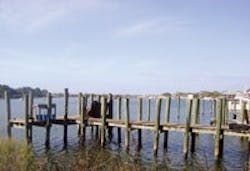Paradise Lost and Found
About the author: Bill Nestor is a writer based in Vermont. Nestor can be reached at [email protected].
The serene fishing community of Carrabelle, Fla., is one of the few small towns in historic Franklin County. Its residents have been harvesting the sea for more than 100 years.
It is hard to imagine why this stretch is called the Forgotten Coast. The name does not fit Carrabelle, a town ideally located on the Gulf of Mexico in the eastern Florida Panhandle. Although it is an idyllic village, Carrabelle has not experienced a population explosion in recent years—just a manageable increase in retirement and vacation homes because of the availability of affordable coastal property. Along with fishing, low- impact tourism is a mainstay of the economy in the village of 1,231 permanent residents.
“We’re on beautiful, scenic Highway 98,” said Utility Supervisor Keith Mock. “There are no traffic lights in the county and no fancy restaurants like in Tallahassee, only 60 miles north of town. But the [community’s restaurants] cook up fresh oysters, shrimp and fish brought in daily by the small fleet of boats and fishermen that live and work in Carrabelle.”
Locals and tourists alike enjoy catching waves at the beach or fishing in the St. James River, which bisects the town before emptying into the Gulf of Mexico.
“Carrabelle is a relaxed, small coastal community with a couple of marinas and a lifestyle centered around the water and beach,” said Glenn Stahl, regional manager for Environment One (E/One). “The pace is laid-back and the life pleas- ant—cars with boogie boards on top and pickups with fishing poles are abundant. It’s the kind of place I’d like to live or retire, a town with Spanish moss-covered live oaks on a pristine bay.”
Trouble in Paradise
The terrain is flat and marshes can be found along the brackish river and into the delta. Pine trees and sandy beaches are plentiful. It was great cause for concern, there- fore, when leaching from individual home septic tanks was found to be contaminating the community’s lifeblood waterway.
“Ninety-nine percent of the homes on River Road had septic tanks, and replacing them immediately became part of the town’s river cleanup project,” Mock said.
Replacement Remedy
Replacing the existing tanks or installing a traditional municipal gravity wastewater system was deemed too costly and an unacceptable environmental risk to the fragile marsh ecosystem.
Carrabelle installed an earlier-generation low-pressure system (LPS) at approximately 10 orphan sites on part of an older town sewer vacuum system and had a good understanding of the benefits of the LPS and grinder pumps.
“The E/One Series 2000 grinder pumps we’d installed previously worked flawlessly and still do,” Mock said. “They are easy to pull and work on if needed.”
The pressure sewer system is powered by grinder pumps. The system uses small-diameter pipes and grinder pumps, which often are installed at each home. The grinder pump station collects all of the wastewater from the home and grinds it into slurry. The wastewater is then pumped to a larger sewer main or directly to a wastewater treatment plant.
While many gravity sewer systems use large mains that are installed in deep trenches, pressure sewer pipes may be as small as 11/4 in. in diameter and follow the contour of the land. These small trenches can mean significant savings. Pressure sewer systems are used in areas where a conventional gravity sewer system cannot be installed, or where it is too expensive to do so. The land may be very flat, rocky, hilly or wet.
“E/One’s LPS and grinder pump are ideal for the high water table, Gulf storm surges and fragile ecosystem created by the level ground and salt marsh areas found in Carrabelle,” said Victoria Schmidt of Water Resources Technologies (WRT), E/One’s regional distributor and service representative.
Fine-Tuning to Avoid Failure
E/One developed the concept of the household grinder pump in 1969. The Extreme grinder pump was introduced in 2007 as an improvement to the original. The Carrabelle project was one of the first to install the new pump.
When it came time to replace additional septic systems, the com- pany’s LPS, including the new grinder pump, was selected. In 2007, the systems were installed at 125 single family homes on River Road, some of which were built in the 1970s and others as recently as 2005.
“WRT took over the project after it was in the ground and soon was having a disproportion- ate number of issues and callbacks for pump failure. We were getting three to four calls per week,” said Connor Alexander of WRT.
“We couldn’t keep up with all the pump failures,” Mock added. ”There were just too many to deal with. I was perplexed especially because my previous experience with the product was so positive.”
The grinder pumps had been installed in other parts of the country and were performing flawlessly.
“The failure rate was high— about 25% of those installed in Carrabelle were having problems,” Schmidt said. E/One sent in a team of engineers to investigate.
“E/One and WRT stood by the product, investing significant resources to resolve the problem,” said E/One spokesperson George Vorsheim. “It was subsequently determined that the failure was the result of a faulty lot of switches exacerbated by the high heat and humidity indigenous to Carrabelle that negatively affected their operation.”
“The switches were redesigned and replaced,” Schmidt said. “There have been few service calls since.”
Download: Here
